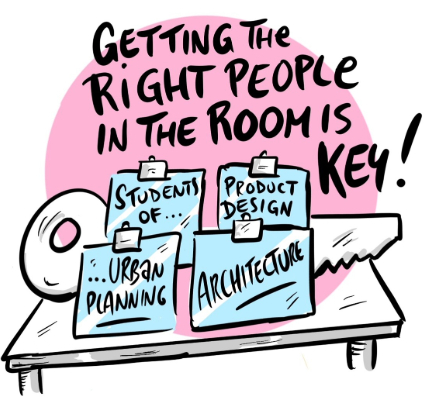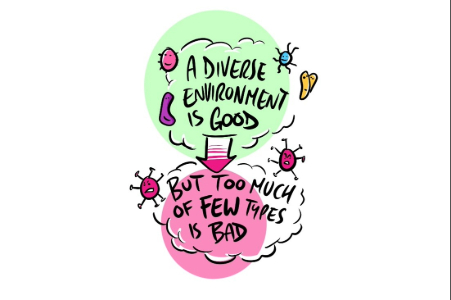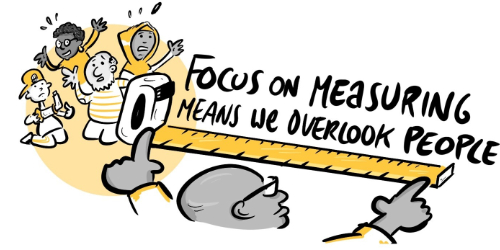Invisible Air, Visible Stakeholders
Posted on October 13, 2025 by Sophie A. Mills, Sana G. Shetty, Gillian H. Drew, Kerry A. Broom, Emma Marczylo, and Philippa Douglas
A team of researchers across multiple UK institutions take us behind the scenes of their latest publication 'Use of bioaerosol stakeholder mapping and engagement for the development of future strategic collaborations: a UK perspective' published in Microbiology.

Meaningful science happens when we connect disciplines and engage the right stakeholders. Credit: Dan Andrews, Scribey Sense for Centre for Facilitation.
What are bioaerosols?
When small particles from biological sources such as plants or trees get into the air, they create bioaerosols. Smaller particles can separate from larger sources through both natural and man-made processes. Fungal spores and pollen are great examples of small particles that can enter the air naturally when carried on the breeze or through human activity, for example when processing compost. Other bioaerosols include bacteria, virus, house dust mite, pet dander and plant debris.
Are bioaerosols bad?
Bioaerosols are everywhere; indoors and outdoors in every breath we take. But what does that mean for our health? We need to come into contact with a wide range of different bioaerosols to help develop a healthy immune system that is well adapted to the natural environment we live in. However, some bioaerosols can be harmful, for example causing infection or allergy in sensitive individuals. That’s why we need to monitor what is in the air and how that changes over time. For a deeper dive into why diversity in our exposure matters, check out our previous blog.

And who cares?
We, the authors of this work, have come together to better understand how the air we breathe can both positively and negatively impact our health. We are a group of experts working in different sectors including academia and government, but we recognise that there are many more voices that need to be heard. In fact, everybody who regularly breathes air (and yes, that is all of us) might have a stake in bioaerosols, especially those of us who suffer from allergies or are concerned about household mould. This research seeks to map the diverse and multidisciplinary community that has an interest in bioaerosols. This community we also call our stakeholders.
What did we do?
We sent out a questionnaire and organised workshops to reach out to our stakeholders. In the workshops, we encouraged participants to explore and compare their own knowledge, experiences and interactions. The workshops promoted trust and respect, a crucial foundation for future impactful collaboration. This people-focused approach helped us to keep sight of the bigger picture instead of only focusing on our own interests and disciplines. By understanding other stakeholders’ needs and interests, we could identify missing skill gaps and potential new stakeholders that we might have been unaware of before.
Another key part of our work involved understanding not just who the stakeholders are, but how they relate to one another. We also invested time in mapping these relationships and how different groups interact, influence, and perceive each other. This helped us uncover hidden connections and better understand the dynamics within the bioaerosol community.

Are we getting the right people in the room?
Some of our key collaborators are researchers in academia and government who provide scientific evidence to better understand bioaerosols and their health impacts. Other government scientists, policymakers and regulators are then responsible for turning this evidence into advice and policies to protect and improve the environment and our health. Some industries are innovating new technologies to aid monitoring of these particles. We also identified non-government organisations, charities and the wider public as important stakeholders.
For this project, we produced an interactive stakeholder map that can be updated over time. The document can be used to identify target audiences, collaborative partnerships, communication opportunities, research dissemination approaches or funding applications.
Although this work is specifically about bioaerosols in the UK, the approach, methodology and tools could be applied to other geographical areas and disciplines. We share our experience in our recent publication that can be used by other researchers to realise similar benefits within their own field. No previous experience in stakeholder mapping is needed to modify and use our approach.
What have we learned?
Stakeholders come with diverse and unique perspectives, priorities, knowledge and influence. That’s why it is so important to identify the right stakeholders, map their interactions and relationships, and facilitate engagement. We were able to do so by using our unique skill set and connections in different organisations, such as UKHSA, the Environment Agency, BioAirNet and academia. We established a collaborative community through sharing relevant information and opportunities. The facilitated workshop approach also allowed us to mitigate potential conflict and overcome blockers caused by the different perceptions stakeholder groups had of each other. Mapping stakeholder relationships helped us understand connections, which revealed blind spots, surfaced new opportunities for collaboration, and helped us navigate differing priorities and perceptions across the community.
But this is just the beginning. Our work has laid a good foundation for further work to capture even more voices and add different contexts and experiences. That’s why we’re inviting others—across disciplines, sectors, and borders—to build on what we’ve started.
Bioaerosols don’t respect boundaries, and neither should our thinking. Because in the end, understanding bioaerosols isn’t just about particles in the air —it’s about the health of the environments we all share.
Acknowledgements
This work was funded by the indoor/outdoor bioaerosols interface and relationships network (BioAirNet), funded by a UK Research and Innovations grant (NE/V002171/1). This study was also part funded by the National Institute for Health and Care Research (NIHR) Health Protection Research Unit (HPRU) in Environmental Change and Health (NIHR 200909), a partnership between the UK Health Security Agency (UKHSA) and the London School of Hygiene and Tropical Medicine, University College London and the Met Office; the NIHR HPRU in Environmental Exposures and Health (NIHR 200880) and the NIHR HPRU in Chemical and Radiation Threats and Hazards (NIHR 200922), a partnership between UKHSA, Imperial College London, the University of Cambridge and King’s College London; and the NIHR HPRU in Environmental Exposures and Health developmental award (NIHR 200901), a partnership between UKHSA, the University of Leicester and the Health and Safety Executive (HSE). The views expressed here are those of the authors and not their associated affiliations or funders.
We thank all of our professional participants who completed the questionnaires and/or participated in the workshops. We thank Dr Zaheer Nasir and Emma-Jane Goode for their assistance with the project.
